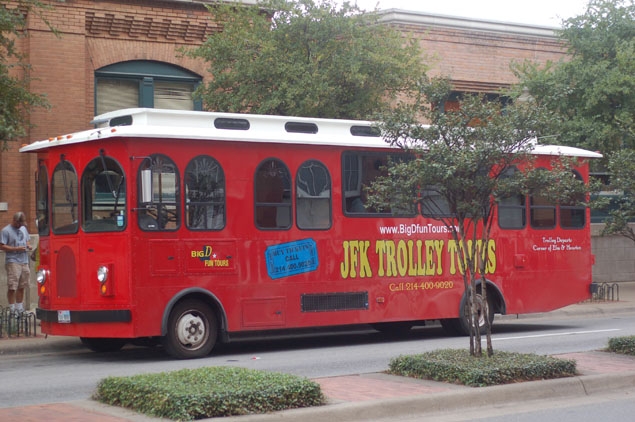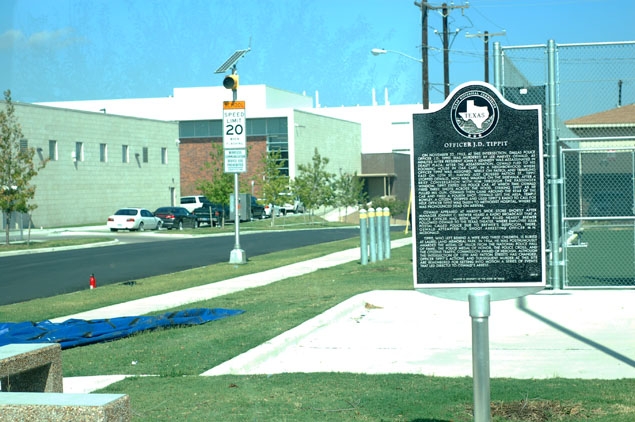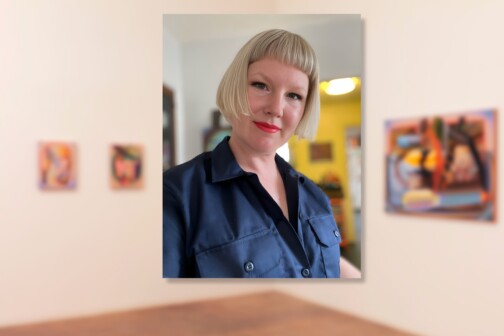
From a distance, the candy-apple red trolley parked on the corner of Elm and Houston streets looked more like a prop from Mister Rogers’ Neighborhood than an appropriate mode of transportation while meditating upon the assassination of President John F. Kennedy.
Similarly out-of-place-looking was Michael “Scott” Aston, owner and operator of Big D Fun Tours, who cheerily invited passers-by to join him as he traced the routes of Kennedy’s motorcade through the city and Lee Harvey Oswald’s attempt to flee the scene. From the grin on his face and lively kick in his step, I would have guessed Aston was selling deep-fried Nutella or an eighth Harry Potter book — really, anything besides tickets to hear someone talk for an hour about manslaughter. But something about seeing “Fun Tours” and “Assassination” in the same heading felt oddly enticing, if borderline morbid, so I stepped onto the trolley to find out what could be “fun” about reliving the events of November 22, 1963.
On the inside, the refurbished trolley looked just as charming as a Disney Land streetcar, but with the added benefits of air conditioning to keep all 20 or so passengers cool in the afternoon heat. Across the aisle from me sat a pair of college students who had their Instagram apps ready to document the tour on their iPhones, but the rest of passengers were mostly middle-aged couples who had recently come out of the Sixth Floor Museum, stacks of glossy exhibit brochures still in their hands. Most of the passengers were visitors passing through the city; Kelly Leger, for example, came from Florida to visit her family in Dallas, and a family of three had come from Australia. Others, like me, had recently moved to Dallas from out-of-state.
After a group of older women filled in the remaining seats, Aston put on his headset and announced, “Folks, welcome to 1963.”
As someone who didn’t know that Kennedy’s assassination took place in Dallas until I saw the cover of Stephen King’s 11/22/63, I was overwhelmed by the number of details Aston covered with the first few minutes of his narration. He related it all with the relaxed tone someone would use to refer to the ending of a story that everybody has already read. Although I’ve lived in the United States long enough to have learned about the nation-wide implications of Kennedy’s assassination, I haven’t lived in Dallas long enough to have known what folks were referring to when they say “the grassy knoll” or “the School Book Depository.” I nod along upon such a reference, but feel like a bit of an impostor—just like anytime I try to throw “y’all” into a conversation.
Hearing Aston discuss his intimate knowledge about the event—like Texas Governor John Connally’s suggestions to move the presidential fundraising site, the personal disagreements between the Kennedys and Vice President Lyndon B. Johnson, the corset Kennedy was wearing in the convertible to ease his back problems—made me feel like I’d stepped into a conversation that was too sophisticated for someone with no roots in this city and no experience with Kennedy’s presidency besides a high school history course.

As if he’d read my mind, Aston set me at ease by taking a few steps backward and recounting the general climate surrounding Kennedy’s presidency. “A lot of things had to fall into place for this day to happen,” he said. While he drove us through the Friday afternoon traffic down Harwood, Main, and Elm streets, Aston set the stage for Kennedy’s visit by describing American culture in the early 1960s; from the momentum of the civil rights movement to the Cuban missile crisis, he related some of the biggest issues on people’s minds shortly before the Kennedys’ trip to Dallas.
“Presidents—they didn’t come to Texas,” Aston went on, describing the excitement surrounding the day of Kennedy’s motorcade as more than 150,000 people came to Main Street to catch a glimpse of the president and his wife. “This was more electric than a Beatles concert. The nearest parking spot was 15 blocks away.”
As the trolley turned left onto Elm Street and headed towards the old Texas School Book Depository, all of the passengers straightened up to catch each word of Aston’s play-by-play of the shooting. We craned our necks to get a view of the infamous sixth-floor window, and Aston narrated every detail about the shots heard at Dealey Plaza, with the energy and enthusiasm of a baseball announcer. Adding to the intensity of Aston’s narration were short sound bites from 50-year-old radio announcements and police dispatcher recordings that captured the frenzy of the moment. Even though Aston said the entire shooting took less than six seconds, I was surprised by how quickly our trolley drove past the grassy knoll; half a dozen of the passengers waited until the depository building was barely visible to turn back towards our tour guide.

With the tour’s pivotal landmark behind us, Aston shifted gears towards Oswald, retracing the young man’s steps from the killing of Kennedy to his boarding house in Oak Cliff. Unlike the downtown sites that were surrounded by colorful reminders of modern-day Dallas, the brick building that had briefly housed Oswald looked like it could have been frozen in time. “The house can be yours for $500,000,” added Aston. He explained that homeowner Patricia Hall, whose grandmother ran the boarding house half a century ago, is putting the entire building up for sale.
Our next stop was at 404 E 10th St., where Oswald killed Officer J.D. Tippit, a local policeman who stopped Oswald for questioning less than an hour after the shooting at Dealey Plaza. Aston reenacted the conversation that might have occurred between the two men before the second fatal shooting of the day. After a brief moment of silence, Aston pointed our attention to the other side of the street, where stood Officer Tippit’s memorial, which had just been unveiled in 2012. “It was long overdue, in my opinion,” Aston said. When one of the passengers asked why he dedicated such a significant amount of time to Tippit’s murder during the tour, Aston responded, “If I don’t, who will? He really was a hero.”
When the trolley continued onto Jefferson Boulevard, I was surprised to realize that our route had merged onto none other than my morning commute. We rolled past familiar bakeries and beauty salons, and for the first time during the entire tour, I felt like the Dallas from 1963 and the Dallas I’d moved to last year were the same place. While Aston recounted the details of Oswald’s attempt to hide in plain sight, I had a bit of fun imagining how Oswald would have looked trying to blend into today’s street scene, weaving in and out of quinceañera boutiques and Mexican panaderías.

We continued on to the tour’s remaining stops: Oswald’s arrest at the Texas Theater, the entrance to Jack Ruby’s nightclub, and the old Dallas city jail where Ruby shot and killed Oswald on live television. As he had done so dynamically during the entire tour, Aston related specifics about the characters, the scenery, and the circumstances of Oswald’s final moments: how Dallas police had planned on using an armed car as a decoy during Oswald’s transfer from the Dallas police headquarters to the county jail, how Ruby wired $25 to one of his strippers at Western Union just four minutes before shooting Oswald, and how Sheba, Ruby’s Daschund, had been locked in her owner’s car for the entire event.
The attention to detail that had felt overwhelming at the beginning of the tour was now the lifeline I used to connect his descriptions of the past with the visual reality of the present. While I appreciated being so close to each site on the tour, seeing the Dallas police headquarters or the School Book Depository from the inside of a trolley didn’t feel much different than walking by those same buildings on my lunch break.
I certainly agreed with passenger Kelly Reger when she said, “It’s so interesting to be right in the same spot, right where everything happened.” But simply being in the same physical spot as each historic event wasn’t enough for me to reconcile the modern-day scenery just outside the window with the distant, black-and-white past I imagined on my own. It was Aston’s descriptions of seemingly insignificant details—the ones I hadn’t read in my 10th grade American Studies textbook—that brought these last few scenes to life amidst the bustle of Dallas’ present.
As I stepped off Aston’s bright red trolley on Houston Street at the end of the tour, I thought about what had drawn me to it in the first place. I didn’t consider myself a history buff or a JFK enthusiast, so what had been enjoyable about recalling one of this city’s most tragic events?
Sure, I came away from the tour with a bunch of facts that may or may not come in handy at some future trivia night. But I also came away with the feeling that, despite being a transplant, I could finally claim my own tiny connections to the city that saw this event half a century ago. If you ask me about where I left my car this morning, I could say I’m parked a block away from Jack Ruby’s former nightclub. If you ask me how to get back to my apartment, I could say it’s the same road along which Oswald took a taxi home. And if you ask me to say “y’all”—well, maybe I’m not quite there yet.
Paulina Lopez is a DMagazine.com intern.




